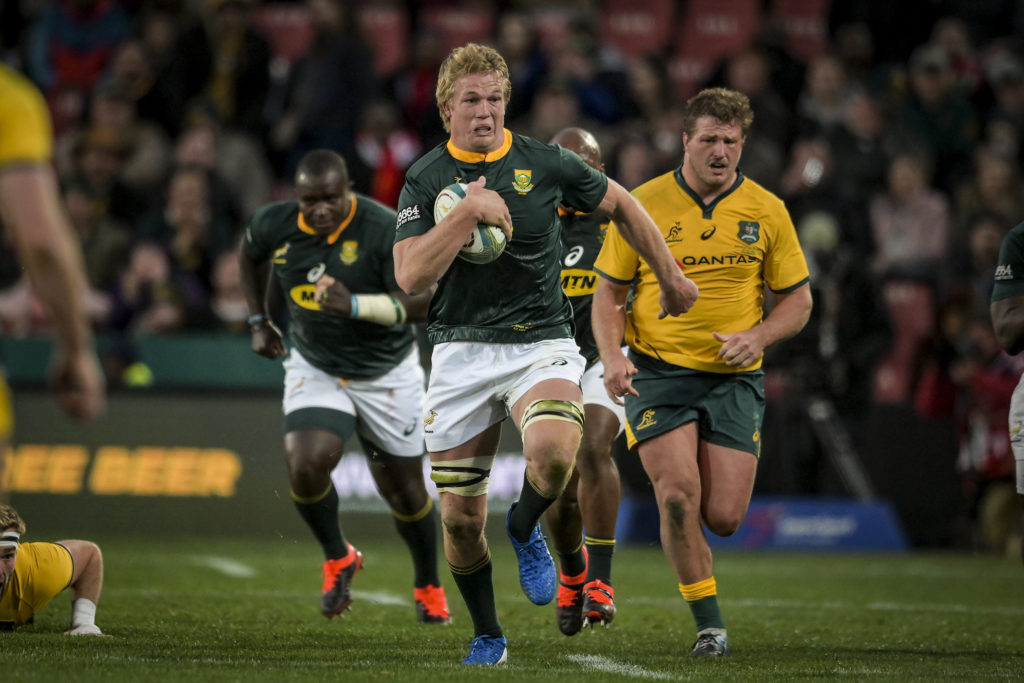Pieter-Steph du Toit’s recent success as a Springbok flank makes sense when looking at his schoolboy rugby years, writes DYLAN JACK.
The day: 19 September 2015. The venue: Brighton. Japan have just claimed a historic victory over the Springboks in one of the greatest upsets in World Cup and possibly Test rugby history. Du Toit is played at flank for the first time in his Springbok career. Following the match Du Toit, and coach Heyeneke Meyer, are both vilified in the media, not least because Du Toit was picked at blindside ahead of a developing Siya Kolisi.
Fast forward to just over a year and Du Toit is once again picked at blindside flank, this time by new Bok coach Allister Coetzee. Again he is roasted as he twice gets given a runaround by England scrumhalf Danny Care at Twickenham, with the hosts sprinting to a 37-21 victory.
At that stage, it looked like the so-called experiment was dead in the water. Having played most of his professional career as a lock for the Sharks and then Stormers, it looked like Du Toit was destined to remain in that position.
However, very few would have predicted what would happen to him under Rassie Erasmus. Over the last two years, Du Toit has gone about establishing himself as one of the world’s best Test flankers. Standout performances against the All Blacks in Wellington – one of them contributing to the Boks’ first win in New Zealand in nine years – have done much to endear him to the South African rugby-watching community.
But when looking at Du Toit’s roots, his recent success in the position should not come as a surprise.
One of the most knowledgeable people about Du Toit’s grounding is Marius de Jager, a high school rugby coach at Hoërskool Swartland. De Jager coached Du Toit from U14 level through to U16 and then for periods as a 2nd XV coach and as the school’s 1st XV assistant coach.
According to De Jager, Du Toit started his rugby as a loose forward and was initially used as a No 8 until the end of his U16 year. Basically, his first three years of rugby came as a loose forward.
However, after growing quite tall between his U16 and U17 years, he missed out on selection for the Boland U17 Elite squad as the selectors decided that he was too big to play eighthman. It was only during Du Toit’s Grade 11 year that he was first asked to move to lock.
He refused, wanting to remain a loose forward, and subsequently played most of the year for the school’s 2nd XV, but still managed to finish the year as a No 7 in the school’s 1st XV.
However, a change came about when selectors for the Boland Craven Week side asked that Du Toit be moved to lock if he was going to make the U18 provincial squad. After some convincing, Du Toit agreed to the move and played at lock full time for the 1st XV in his Grade 12 year. The move was further entrenched when Sharks scouts spotted him playing in the position against Paarl Boys’ High, and from there scouted him as a lock and not a flank.
To sum up, Du Toit transitioned from flank to lock as a schoolboy and then had to make the transition back to flank as a professional.
De Jager told SARugbymag.co.za that Du Toit always saw himself as a flank.
‘I remember very clearly, between his U16 and U17 year, when we asked him to play lock,’ De Jager said. ‘He told me that one day he is going to play for the Springboks as a No 7. That was his dream.
‘I told him he could still do it because the Springboks like tall No 7s who almost play like a lock. He was very clear and adamant that he wanted to play for the Springboks as a No 7.’
When looking at this background, it could be that having made the physical transition to lock as a professional, Du Toit was not physically ready to make the move to flank in 2015 and 2016. He probably also was not helped by the fact that he was only meant to be on the bench in Brighton, but was forced into the starting lineup after Willem Alberts picked up an injury.
That Du Toit was able to make a successful transition from that stage should come as no surprise, as De Jager claims that he did not set foot in a gym as a schoolboy, with his athleticism and physicality all coming from his work on the family farm.
‘He didn’t gym at any stage at school,’ De Jager says. ‘He worked on the farm. When he got to the Sharks, they liked that he had a good frame and they could work with him and develop him in their gym. So he was quite a raw talent and I had not seen him inside a gym at school. So he has a lot of natural fitness and strength.
Du Toit has shown a determination to return to his old position and make it his own. He has clearly worked hard on his conditioning under Erasmus and the Springbok coaching unit, becoming fitter and faster over the ground and therefore more adept in the loose trio.
‘There was an absolute determination in him to make it as a pro,’ De Jager adds. ‘He never missed training without a good reason. He always worked very hard and was tough. He took it very seriously. From when he was small, he was serious about his rugby.’
MALLETT: ‘Du Toit’s engine runs all day’
Photo: BackpagePix





